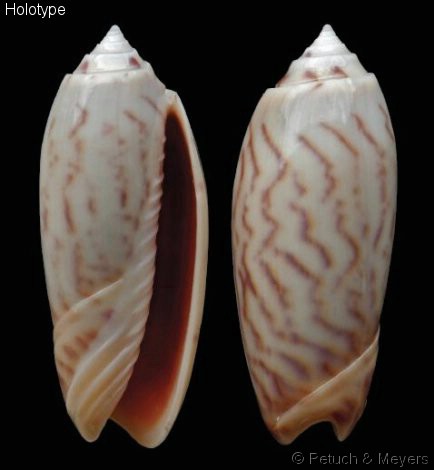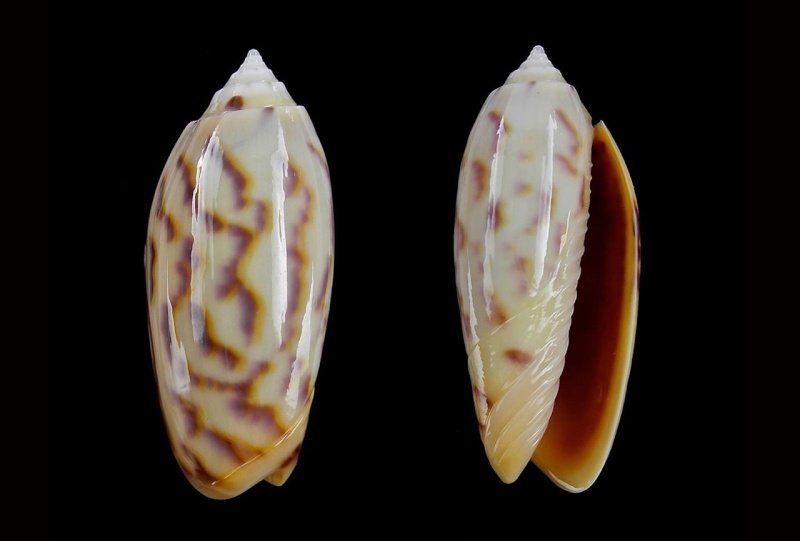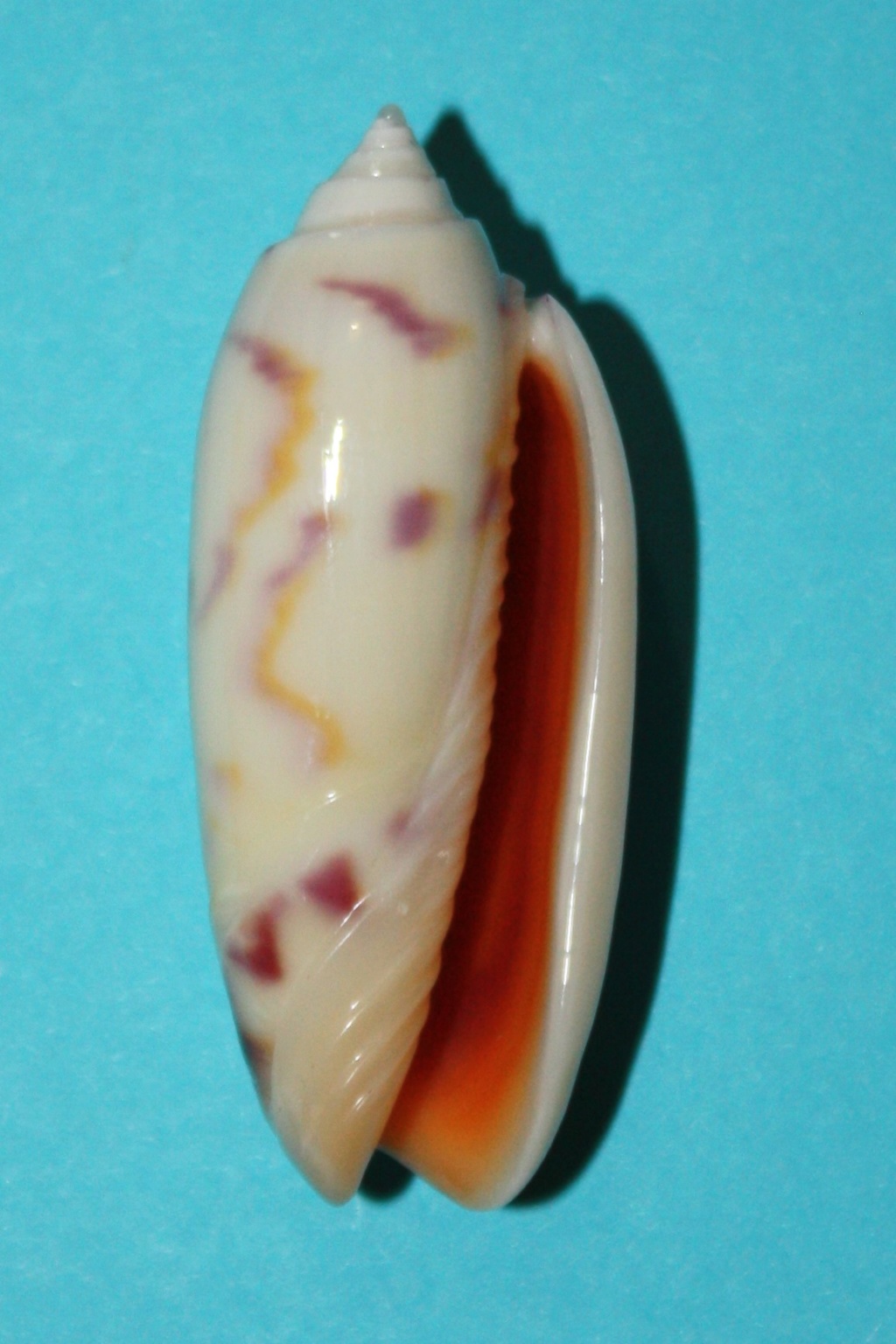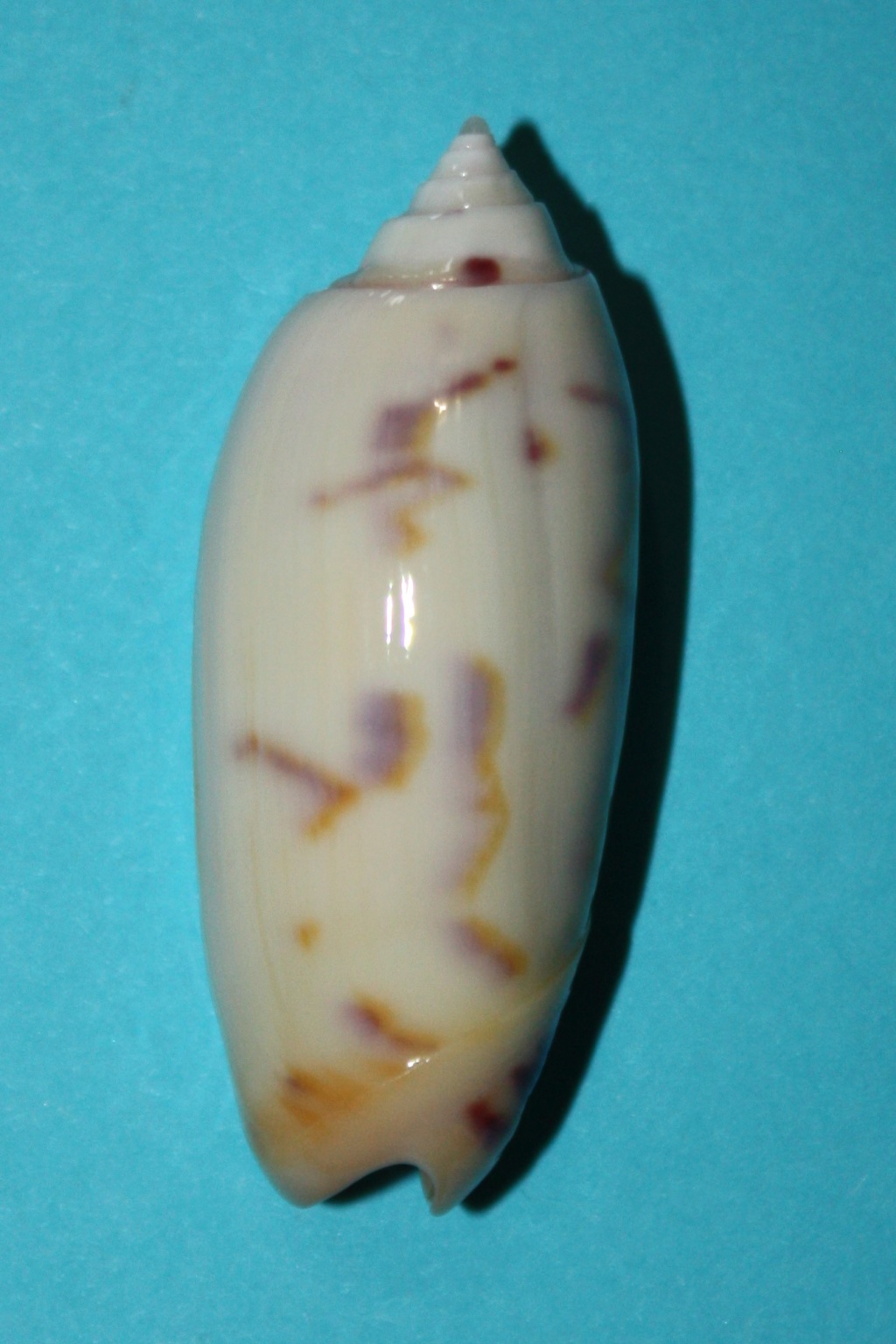 Miniaceoliva efasciata thierryi (Petuch & Myers, 2014)
Miniaceoliva efasciata thierryi (Petuch & Myers, 2014)
Sam 17 Mai 2014 - 1:23
Une autre tres jolie olive nomee par Edward Petuch... son nom vous donnera une indicatioon

Description: Shell small for genus, averaging 45 mm, elongated, cylindrical, with slightly rounded, convex sides; spire proportionally low, subpyramidal, distinctly stepped; shoulder very sloping, almost obsolete, grading directly into spire whorls; filament channel proportionally wide, deep, bordered by prominent raised carina; fasciole and fascicular band small, narrow, comprising only anterior one-fourth of body whorl; body whorl color pale blue or bluish-cream, overlaid with regularly-spaced large purple brown zig-zag flammules arranged in zebra-striped pattern; shoulder area and carina of filament channel without pattern, devoid of zebra stripes, being uniform blue-cream in color; spire whorls partially callused, cream-blue in color, marked with widely-spaced large, prominent purple oval-shaped spots; edge of filament carina with few, widely-separated small pale purple flammules, around 4-6 per whorl; columella wide, cream-white in color, ornamented with 13-15 large tooth-like plications; smaller secondary plications often present between larger primary plications; fascicular band marked with 6-9 large, regularly-spaced, elongated purple spots; aperture proportionally wide, slightly arcuate, widening toward anterior end; interior of aperture deep red-orange; protoconch cream-white in color, proportionally large, rounded, domelike, composed of 2 whorls.
Type Specimens: Holotype: length 45 mm, width 17 mm, LACM 3273; Paratypes: length 46 mm, width 19 mm, from the same locality as the holotype, in the research collection of the senior author; length 46 mm, from the same locality as the holotype, in the collection of Thierry Vulliet, Queensland, Australia.
Type Locality: Found in clean coral sand, 2.5 m depth, off Tarawa Atoll, Kiribati, Micronesia.
Range: At present, known only from Kiribati (formerly the Gilbert Islands), particularly Tarawa Atoll, and Tuvalu (formerly the Ellis Islands), southwestern Micronesia.
Etymology: Named for Thierry Vulliet of Arundel, Queensland, Australia; inspired amateur naturalist and conchologist, who first brought the new subspecies to our attention.
Discussion: This new Kiribati subspecies is one of the two newly-discovered members of the Miniaceoliva miniacea-efasciata species complex that are described in this paper. The close-knit
species group, confined biogeographically to the Southwest Pacific, Melanesia, Micronesia, and Polynesia areas (Petuch and Sargent, 1986: 31, 44, figure 25), was originally thought to comprise a single species, Miniaceoliva miniacea (Roding, 1798) and its two subspecies, efasciata (Dautzenberg, 1927) and lamberti (Jousseaume, 1884) (Petuch and Sargent, 1986: 94-96). The nominate subspecies, miniacea, ranges from Northern Territory, Australia, through Indonesia, the Philippines, Palau, Vietnam, Taiwan, the Ryukyu Islands, and north to southern Japan, but does not extend into the Indian Ocean or the Central Pacific. Subsequent research on the shell morphologies and biogeographical distributions of the Melanesian, Micronesian, and Polynesian “subspecies” (by the senior author), however, has shown that the species complex is more complicated and diverse than originally thought. Preliminary studies on shell morphology now indicate that the subspecies lamberti and efasciata actually represent distinct full species, each with their own biogeographically-isolated subspecies. These include:
Miniaceoliva efasciata efasciata (Dautzenberg, 1927) (confined to the Central Pacific, including
the Society Islands, Line Islands, Tonga, Cook Islands, the Tuamotus, and the Marquesas)
Miniaceoliva efasciata berti (Terzer, 1986) (Kwajalein and Eniwetok Atolls and the Marshall
Islands; Caroline Islands)
Miniaceoliva efasciata thierryi new subspecies (Kiribati and Tuvalu, Micronesia)
Miniaceoliva lamberti lamberti (Jousseaume, 1884) (Queensland, Australia, the Coral Sea, the
Chesterfield Islands, the Diamond Isles, New Caledonia, and the Loyalty Islands)
Miniaceoliva lamberti chloeae new subspecies (described next in this paper) (Wallis and Futuna
Islands, Fijis, Vanuatu, and the Santa Cruz Islands)
Along with the northwestern Australia-to-Japan Miniaceoliva miniacea, the genus is now known to be represented by three species and three subspecies in the Pacific Ocean basin and peripheral areas. A similar pattern of speciation and geographically-isolated subspecies is seen in the Indian Ocean, where the sister taxon Miniaceoliva tremulina (Lamarck, 1811) has evolved a mirror-image complex containing species such as M. hayesi (Sargent and Petuch, 2012), M. flammeacolor (Petuch and Sargent, 1986), and M. olympiadina (Duclos, 1835) (Sargent and Petuch, 2012).
The new Kiribati subspecies, M. efasciata thierryi, differs from the nominate subspecies in having a smaller, more cylindrical shell, in having a distinctive pale blue and cream base color, in having a color pattern composed of evenly-spaced purple zebra stripes, and in having a clear, unpatterned band around the shoulder. The Marshall Islands subspecies M. efasciata berti, which is restricted to the island archipelagoes north of western Kiribati, differs from its southern congener in having a smaller, broader shell, in having a proportionally higher spire, in having a white base color, and in having a color pattern made up of thin, widely-scattered dark purple flammules.

Miniaceoliva efasciata thierryi new subspecies
(Figure 2E, F)
Description: Shell small for genus, averaging 45 mm, elongated, cylindrical, with slightly rounded, convex sides; spire proportionally low, subpyramidal, distinctly stepped; shoulder very sloping, almost obsolete, grading directly into spire whorls; filament channel proportionally wide, deep, bordered by prominent raised carina; fasciole and fascicular band small, narrow, comprising only anterior one-fourth of body whorl; body whorl color pale blue or bluish-cream, overlaid with regularly-spaced large purple brown zig-zag flammules arranged in zebra-striped pattern; shoulder area and carina of filament channel without pattern, devoid of zebra stripes, being uniform blue-cream in color; spire whorls partially callused, cream-blue in color, marked with widely-spaced large, prominent purple oval-shaped spots; edge of filament carina with few, widely-separated small pale purple flammules, around 4-6 per whorl; columella wide, cream-white in color, ornamented with 13-15 large tooth-like plications; smaller secondary plications often present between larger primary plications; fascicular band marked with 6-9 large, regularly-spaced, elongated purple spots; aperture proportionally wide, slightly arcuate, widening toward anterior end; interior of aperture deep red-orange; protoconch cream-white in color, proportionally large, rounded, domelike, composed of 2 whorls.
Type Specimens: Holotype: length 45 mm, width 17 mm, LACM 3273; Paratypes: length 46 mm, width 19 mm, from the same locality as the holotype, in the research collection of the senior author; length 46 mm, from the same locality as the holotype, in the collection of Thierry Vulliet, Queensland, Australia.
Type Locality: Found in clean coral sand, 2.5 m depth, off Tarawa Atoll, Kiribati, Micronesia.
Range: At present, known only from Kiribati (formerly the Gilbert Islands), particularly Tarawa Atoll, and Tuvalu (formerly the Ellis Islands), southwestern Micronesia.
Etymology: Named for Thierry Vulliet of Arundel, Queensland, Australia; inspired amateur naturalist and conchologist, who first brought the new subspecies to our attention.
Discussion: This new Kiribati subspecies is one of the two newly-discovered members of the Miniaceoliva miniacea-efasciata species complex that are described in this paper. The close-knit
species group, confined biogeographically to the Southwest Pacific, Melanesia, Micronesia, and Polynesia areas (Petuch and Sargent, 1986: 31, 44, figure 25), was originally thought to comprise a single species, Miniaceoliva miniacea (Roding, 1798) and its two subspecies, efasciata (Dautzenberg, 1927) and lamberti (Jousseaume, 1884) (Petuch and Sargent, 1986: 94-96). The nominate subspecies, miniacea, ranges from Northern Territory, Australia, through Indonesia, the Philippines, Palau, Vietnam, Taiwan, the Ryukyu Islands, and north to southern Japan, but does not extend into the Indian Ocean or the Central Pacific. Subsequent research on the shell morphologies and biogeographical distributions of the Melanesian, Micronesian, and Polynesian “subspecies” (by the senior author), however, has shown that the species complex is more complicated and diverse than originally thought. Preliminary studies on shell morphology now indicate that the subspecies lamberti and efasciata actually represent distinct full species, each with their own biogeographically-isolated subspecies. These include:
Miniaceoliva efasciata efasciata (Dautzenberg, 1927) (confined to the Central Pacific, including
the Society Islands, Line Islands, Tonga, Cook Islands, the Tuamotus, and the Marquesas)
Miniaceoliva efasciata berti (Terzer, 1986) (Kwajalein and Eniwetok Atolls and the Marshall
Islands; Caroline Islands)
Miniaceoliva efasciata thierryi new subspecies (Kiribati and Tuvalu, Micronesia)
Miniaceoliva lamberti lamberti (Jousseaume, 1884) (Queensland, Australia, the Coral Sea, the
Chesterfield Islands, the Diamond Isles, New Caledonia, and the Loyalty Islands)
Miniaceoliva lamberti chloeae new subspecies (described next in this paper) (Wallis and Futuna
Islands, Fijis, Vanuatu, and the Santa Cruz Islands)
Along with the northwestern Australia-to-Japan Miniaceoliva miniacea, the genus is now known to be represented by three species and three subspecies in the Pacific Ocean basin and peripheral areas. A similar pattern of speciation and geographically-isolated subspecies is seen in the Indian Ocean, where the sister taxon Miniaceoliva tremulina (Lamarck, 1811) has evolved a mirror-image complex containing species such as M. hayesi (Sargent and Petuch, 2012), M. flammeacolor (Petuch and Sargent, 1986), and M. olympiadina (Duclos, 1835) (Sargent and Petuch, 2012).
The new Kiribati subspecies, M. efasciata thierryi, differs from the nominate subspecies in having a smaller, more cylindrical shell, in having a distinctive pale blue and cream base color, in having a color pattern composed of evenly-spaced purple zebra stripes, and in having a clear, unpatterned band around the shoulder. The Marshall Islands subspecies M. efasciata berti, which is restricted to the island archipelagoes north of western Kiribati, differs from its southern congener in having a smaller, broader shell, in having a proportionally higher spire, in having a white base color, and in having a color pattern made up of thin, widely-scattered dark purple flammules.
_________________
The cure for anything is salt water - sweat, tears, or the sea.
~ Isak Dinesen
 Re: Miniaceoliva efasciata thierryi (Petuch & Myers, 2014)
Re: Miniaceoliva efasciata thierryi (Petuch & Myers, 2014)
Sam 17 Mai 2014 - 10:19
ba y en a pour toi ! lol
 Bernard Clavé †Modérateur
Bernard Clavé †Modérateur
- Messages : 7265
Date d'inscription : 28/06/2011
Age : 82
Localisation : Gironde
 Re: Miniaceoliva efasciata thierryi (Petuch & Myers, 2014)
Re: Miniaceoliva efasciata thierryi (Petuch & Myers, 2014)
Dim 18 Mai 2014 - 6:43
祝贺你的炮弹是在您的姓名。
_________________
Je pense ce que je dis, je dis ce que je fais et je fais ce que je dis...... Et qu'importe le "Qu'en dira t'on".......



Nanard33
 Re: Miniaceoliva efasciata thierryi (Petuch & Myers, 2014)
Re: Miniaceoliva efasciata thierryi (Petuch & Myers, 2014)
Dim 18 Mai 2014 - 7:00
Oui Nanard je sais le Cheyenne c est du chinois pour toi...hahahha
mais j ai voulu mettre l original de la description....
mais j ai voulu mettre l original de la description....

_________________
The cure for anything is salt water - sweat, tears, or the sea.
~ Isak Dinesen
 Clem4102Modérateur
Clem4102Modérateur
- Messages : 1935
Date d'inscription : 01/03/2011
Age : 47
Localisation : Corrèze
 Re: Miniaceoliva efasciata thierryi (Petuch & Myers, 2014)
Re: Miniaceoliva efasciata thierryi (Petuch & Myers, 2014)
Lun 19 Mai 2014 - 22:10
Cela fait toujours plaisir de voir que ma collection d'olive ne finira pas de s'agrandir si on en décrit encore de temps à autres 
A+

A+
 Bernard Clavé †Modérateur
Bernard Clavé †Modérateur
- Messages : 7265
Date d'inscription : 28/06/2011
Age : 82
Localisation : Gironde
 Re: Miniaceoliva efasciata thierryi (Petuch & Myers, 2014)
Re: Miniaceoliva efasciata thierryi (Petuch & Myers, 2014)
Jeu 5 Mar 2015 - 14:29
Photos Thierry VUILLET avec son autorisation.
Voici quelques Miniaceoliva efasciata thierryi (Petuch & Myers, 2014)
Tarawa Atoll, Kiribati, Ambo beach - Dans le sable autour d'algues, à marée basse
Taille 40,2 mm

Taille 40,4 mm

Taille 40,5 mm

Taille 45,6 mm

Voici quelques Miniaceoliva efasciata thierryi (Petuch & Myers, 2014)
Tarawa Atoll, Kiribati, Ambo beach - Dans le sable autour d'algues, à marée basse
Taille 40,2 mm

Taille 40,4 mm

Taille 40,5 mm

Taille 45,6 mm

_________________
Je pense ce que je dis, je dis ce que je fais et je fais ce que je dis...... Et qu'importe le "Qu'en dira t'on".......



Nanard33
 Clem4102Modérateur
Clem4102Modérateur
- Messages : 1935
Date d'inscription : 01/03/2011
Age : 47
Localisation : Corrèze
 Re: Miniaceoliva efasciata thierryi (Petuch & Myers, 2014)
Re: Miniaceoliva efasciata thierryi (Petuch & Myers, 2014)
Dim 31 Mai 2015 - 13:55
Magnifique échantillon de cette nouvelle espèce  , il ne reste plus qu'à en trouver dans les bourses ou autre.
, il ne reste plus qu'à en trouver dans les bourses ou autre.
Elle a des airs de pondérosa avec l'ouverture d'une miniacea.
A+
 , il ne reste plus qu'à en trouver dans les bourses ou autre.
, il ne reste plus qu'à en trouver dans les bourses ou autre.Elle a des airs de pondérosa avec l'ouverture d'une miniacea.
A+
 PLFAssidu
PLFAssidu
- Messages : 3037
Date d'inscription : 25/04/2010
Age : 69
Localisation : 1 rue de la Tuilerie 55500 Foucheres aux Bois
 Re: Miniaceoliva efasciata thierryi (Petuch & Myers, 2014)
Re: Miniaceoliva efasciata thierryi (Petuch & Myers, 2014)
Dim 23 Sep 2018 - 16:56
Permission de ce forum:
Vous ne pouvez pas répondre aux sujets dans ce forum



